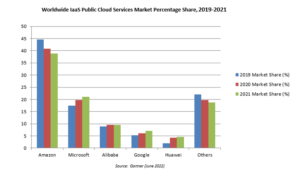Cloud computing is nowadays a catchy phrase among information technology enthusiasts, trend observers, and practitioners alike. The reason is that the “cloud” is becoming the development center for the new applications and services that are being produced at a faster pace year on year. The ever-increasing speed of internet connectivity coupled with the high processing power of computers enables the development of a lot of innovative services without necessarily “owning” but “leasing” the ICT infrastructure that is required for such innovations – all thanks to cloud computing. This is feasible mainly due to broadband internet that makes it possible to communicate with the resources remotely. Thus, the availability of high-performance ICT resources to many organizations via the internet makes the term cloud computing fit for purpose. In this article, we will try to demystify this new paradigm and how it can affect small and medium businesses in Ghana and Africa at large.
The various forms of the cloud offering
Cloud computing comes in various forms. Its most basic form is the provision of computer hardware services with capabilities that are not available on premises. Some applications require high memory or high processing power that are too expensive or cost-inefficient to procure as an enterprise for ownership. There are services available where such high capability computing services are provided as a service over the internet. This cloud computing offering is therefore termed Infrastructure as a service (IaaS).
There is also the Software-as-a-Service (SaaS) cloud computing offering. Here there are many variants because a lot of innovation takes place on this level and is open to all enterprises. There are various kinds of offerings from ERP (Enterprise Resource Planning) to CRM (Customer Relation Management) software. Salesforce as a company became a dominant player in the CRM software market, thanks to cloud computing. Even the good old free email services of Google, Yahoo, and Hotmail are based on cloud computing since the mail servers are not hosted on-premises, as in many local companies.
The other variant of cloud computing proposition is Platform-as-a-Service (PaaS). This is the option where a whole development environment is created for software developers with limited hardware resources. They are provided with an ecosystem of tools to create new software without owning the full architecture on local premises. They can also easily scale up their requirements of such an environment based on their customer demand or volume. Not only do software developers benefit from the Platform-as-a-Service offering; but social media platforms like Facebook can also be categorized as this third option. Thus, developers and end users both stand to gain from this offering. In fact, Web 3.0 will leverage the value proposition of Platform-as-a-Service.
The cloud computing market
Whether it is software or a platform, the hardware is required to power it. The infrastructure model of cloud computing, therefore, represents the base on which all other cloud computing propositions repose. This infrastructure service is provided through regional data centers scattered around the world and clustered in availability zones to provide resilience and uninterrupted service availability in the event of disasters in one region or the other. The ICT infrastructure required for the success of cloud computing is therefore a boon for data center service providers. The cloud computing market world leaders like Amazon, Microsoft, Alibaba, Google, and Huawei all depend on such data centers to provide their public cloud services.
The growth trends
The cloud computing market is currently dynamic, with a lot of competition for market share. Despite its pioneering role in the market, Amazon is facing stiff competition from other players such as Microsoft, Alibaba, and Google; over the last three years, while the market share of Amazon has reduced slightly, that of the three closest rivals increased slightly (especially that of Microsoft). Other entrants, like the Oracle cloud, are also trying to carve a niche in this market. The trend also suggests that in the next five years, the dominance of Amazon in the market might be further reduced, leading to a more diversified market. Such a situation will augur well for the pricing of cloud computing services. It will also mean that developers in the future will also need to have a more diverse knowledge of the various vendors in the market.
The promise of the cloud-native model
The cloud computing proposition is now very tempting to many businesses because it helps to tremendously reduce capital expenditure on IT infrastructure while delivering reliable services. Developing an innovative service by using ICT resources available through cloud computing is therefore termed building a cloud-native application. One example is about offering insurance services (pension, life, and auto insurance services, to name a few) completely through cloud resources. This allows the company to focus on its core business while spending relatively less on the ICT infrastructure that supports the business; much like outsourcing the ICT infrastructure. This cloud-native mode of operation obviously comes with its own risks that can be mitigated for a business to thrive. Small and medium enterprises will therefore need the services of ICT professionals known as cloud solution architects to design, build and maintain the cloud-based ICT infrastructure on which the whole enterprise depends.
The risks and mitigations
The major risks associated with deploying a cloud-based architecture for business delivery are three-fold, availability, security, and compliance. The architecture needs to be resilient to outages caused by location-specific incidents that can affect the data centers hosting the cloud services; environmental disasters like fire, floods, or earthquakes can affect the data center location and put out the cloud-based service out of operation. This risk is usually mitigated by creating a redundancy strategy involving hosting the service across over one region to ensure that an incident affecting one region does not completely bring down the service.
The security and compliance aspects of the risks usually go together; business regulators push the compliance agenda with the view of bolstering user security. Some of the compliance requirements include regulation on the location of the data used in providing the service over the cloud. Some regulations insist that the database of service users remains in the same geographic location as the users; for instance, a cloud-based service offering to Ghanaians needs to have the database physically in Ghana. For a business to be compliant with such a regulation, hybrid solutions are usually devised where the database is kept on premises while the rest of the infrastructure is hosted in the cloud in another location. The other security aspect of risk mitigation involves ensuring the cloud model is resistant to cyber-attacks. This aspect requires the business to ensure the cloud solution partner already has strong security features for its cloud infrastructure, while the business takes care of the security inside the cloud. All the global cloud solution providers already provide built-in security features.
Conclusion
Cloud computing has been with us for many years albeit in the smaller version of email services like Yahoo Mail, Google Mail, Hotmail, etc. Now, this model is becoming pervasive in all business sectors, from e-commerce to e-governance. Cloud-native applications or models are bound to revolutionize the way services are rendered in many industries. Embracing them as a small and medium businesses is the way to go in the current fourth industrial revolution- the digital revolution.
Yayra is a Telecommunications Engineer, AI Specialist (Member, Institute of ICT Professionals, Ghana).
For comments, contact [email protected] / Mobile: +233543758923











